

Rebreather Diving (With my Prescription Dive Mask) on the Fu Sheng Wreck in Sint Maarten
January 2, 2022Rebreather diving in Sint Maarten https://www.youtube.com/watch?v=y_vcB6tv2_I One of the ways we are differentiated is the fact that we are divers,…


